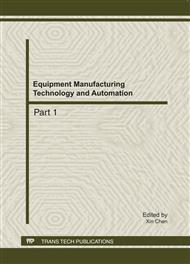[1]
Ryosuke O. Suzuki, Daisuke Tanaka. Mathematic simulation on power generation by roll cake type of thermoelectric tubes, Journal of Power Sources, 2004 (132): 266–274
DOI: 10.1016/j.jpowsour.2004.01.018
Google Scholar
[2]
Lazard Myriam. Heat transfer in thermo- electricity: Modeling, optimization and design[C]//Proceedings of the 7th IASME / WSEAS International Conference on Heat Transfer, Thermal Engineering and Environment, HTE '09: 129-134
Google Scholar
[3]
Yin Liang, Li Maode. Numerical simulation of non-steady temperature field in thermoelectric cooling system and the analysis of its cold node temperature. Cryogenics, 2003, 6: 54-60
Google Scholar
[4]
Ren Depeng, Jia Yang. Numerical simulation for operating characteristics of thermogenerator. Spacecraft engineering, 2008(17)4: 56-61
Google Scholar
[5]
Zhigang Yang, Jeffrey Bozeman and Fred Z S. Thermal-velocity coupling in vehicle thermal system calculations. Proceedings of SAE 01-1204, (2002)
DOI: 10.4271/2002-01-1204
Google Scholar
[6]
Bendell E. Investigation of a Coupled CFD and Thermal Modeling Methodology for Prediction of Vehicle Underbody Temperatures. Proceedings of SAE 01-2044, (2005)
DOI: 10.4271/2005-01-2044
Google Scholar
[7]
Guoquan Xiao, Zhigang Yang, Dong Wang and Wanping Zhang. Investigation of radiation and conjugate heat transfers for vehicle underbody. Proceedings of SAE 01-1819, (2008)
DOI: 10.4271/2008-01-1819
Google Scholar
[8]
Guoquan1 Xiao, Zhigang Yang, Wanping Zhang. Simulation of conjugate heat transfer for vehicle thermal management system. Journal of system simulation, 2010 22(7): 1733-1736
Google Scholar
[9]
Liping Ma, Ping Ning, Aiming Zhang, Quanli Feng, Xueqian Wang. Mathematical modeling of heat transfer in exhaust system of a cold-start engine. 2008, 7: 34-36
Google Scholar
[10]
Hongwu Liu, Zheng Zhang. Research on a novel thermoelectric generator structure for vehicle exhaust gas energy recovery. Energy conservation technology. 2006(24)6: 705-707
Google Scholar
[11]
Zheng Zhang, Xiaopeng Xie, Jianghong Wu. Modeling and numerical analysis of built-in enhanced thermoelectric system. Journal of south china university of technology. 2011, 3
Google Scholar


